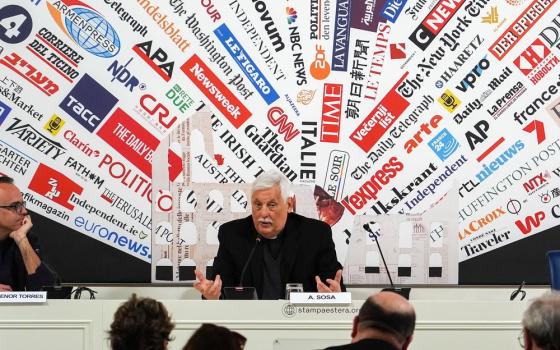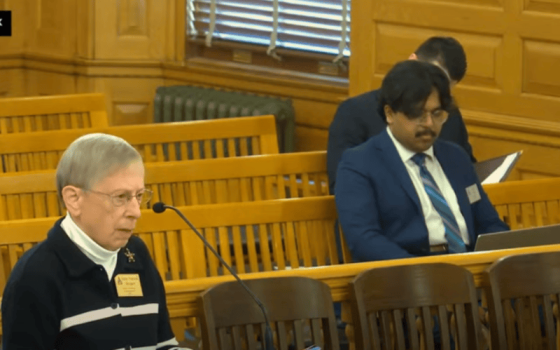On December 3rd to 7th, I had the opportunity to participate in an immersion pilgrimage border trip. The trip was organized in collaboration with the Office for Immigrant Affairs & Immigration Education at the Archdiocese of Chicago, and other organizations. This border trip involved a series of visits to agencies and institutions on the U.S-Mexico border where the participants had a chance to learn about the struggles and outcomes of migration/immigration.
Our group consisted of mostly Hispanic descent young adults; however there were three White-Caucasian individuals, and a member of Asian descent. I observed and realized how in the case of the Hispanic participants much of their understanding on the issue of migration and immigration was based on first-hand experience. The trip put made them think, and reflect on their own family background or history. This was because several of their family members perhaps decades ago, had once crossed the border legally or unauthorized; and throughout the years were able to adjust their status in the U.S. They began reflecting on the struggles their ancestors once went through in order to give them a life in the U.S.
The itinerary of the trip included several of activities and discussions that made the trip essential. We made a visit to the Tucson Courthouse where we witnessed what is called an “Operation Streamline.” Participated in discussions on the current immigration policies given by a community organization, Borderlinks. Went on a hiking trip into the desert with a group called Samaritans, made up of volunteers who provide water, food and emergency medical care to migrants. Shared a meal with staff and parishioners of Most Holy Trinity Parish in Tucson, where we listened to their stories and opinions about migration and the effects of SB1070. We also had the opportunity to gain an educational perspective with a visit to the Arizona-Sonora Desert Museum, learning about life in the desert. We crossed into Mexico and visited a collaborative, bi-national ministry to migrants called the Kino Border Initiative in Nogales, Mexico. We were also very fortunate to meet with Bishop Gerald Kicanas at the Diocese of Tucson. And finally, but not least we visited the Office of Border Patrol in Nogales, AZ.
As part of our preparation for the trip our group had four formation sessions. During one of the formation sessions we listened to the testimonies of participants from the first border trip. These formations were important in order to challenge us in different ways that we didn’t expect. Through the formations we came to realize that we had to be willing to open our minds and hearts to new expectations and accept the Holy Spirit in one mist.
As already mentioned the educational component of this trip included several presentations involving the political, legal, social, economical and pastoral aspects of the immigration phenomenon. I certainly gained plenty of knowledge with the information presented by the agencies we visited.
I personally had two simple goals for the trip, to be receptive to the educational elements of the experience and to try ‘to walk in the shoes’ of a migrant.
With respect to my second goal, that is, to be vulnerable and try ‘to walk in the shoes’ of a migrant. Well, I probably got more than I bargained for. There are three experiences I want to share that made me feel like that goal of vulnerability was accomplished.
Allow me to begin by sharing with you my first moving experience, which was hiking for hours in the desert with the Samaritans. Our first stop was a small border town called Sasabe, AZ. Small community that stands a border patrol station and two miles of a new border fence, made out of wrought iron bars 21 feet high and 6 feet deep in the ground.
The fence slows people down a little bit forcing them to go off the trail, because once you reach the two-mile stretch you are able to cross into the U.S. without any complications. Once that journey was completed we began the hiking trip through the desert. During our walk the Samaritans checked on the water stations along the trails. These trails could tell the stories with just the empty water gallons, worn out shoes and pieces of clothing left behind. Those objects and trails are silent witnesses of the many stories of people who come from all walks of life, trying to make it to the north, to work, to better themselves, to beat poverty, to make some money to help their loved ones whom they have left behind in their home land, and yes so many times, those rugged unforgiving terrains are also witnesses of the stories of death for those whose journey ends sooner than what was expected. Sometimes they are lucky to evade the border patrol and get to their destination across the border. But then there are those times where they are apprehended, processed and deported back to their native countries.
The second journey was the visit to the Tucson Courthouse to witness “Operation Streamline”. As we walked into the courtroom you saw about 70, mostly men wearing handcuffs and shackles they where the detainees, I was besieged by a feeling of sadness. The air of the courtroom was inundated by the smell of the sweat of those poor men and women who probably have not taken a shower in days. Their clothes and physical appearance was in disarray. The wall where they leaned had the marks of the dust that these men brought with them from the desert. This was a testimony of the tortuous crossing that had landed them in this country where they were now being catalogued as “criminals” facing “justice”.
As I watched them I attempted to read the expressions of these men and women, occasionally our sights crossed for an instance as the judge through an interpreter read the charges imputed on them. Many of them seemed confused, scared and overwhelmed by what was going on. It was pretty obvious that no one really understood all the legal jargon that was being read to him or her. Even when you understand English you really don’t understand much of what is being said. I tried to put myself in their shoes; asking myself what would I feel? My response was simple – fear. I asked myself why? Why would these people see me as a criminal? Why is it so wrong to want to find a job in order to put bread on the table for my family? Why?
Perhaps the best way to conclude this reflection is by giving witness as to what happens on the other side of the border. The Kino Border Initiative in Nogales, Mexico – which is a Jesuit ministry, a cooperative effort among six religious organizations that strive to accompany migrants affected by the consequences of migration. It is strategically located in the twin cities of both Nogales, southern AZ and northern Sonora, which is a major port of entry and deportation for migrants in the southwest.
Our visit began in the “comedor” a soup kitchen where migrants can receive meals and basic services such as clothing, free phone calls to either Mexico or the US, and other useful information. During our visits the group of deportees was a large group of women from Puebla, Mexico. Nieves, a woman who was trying to make it to Philadelphia with her three daughters was one of the first that I met. Nieves was distressed to tears for her failure in attempting to cross the border; but the burden was much greater, she had exposed her daughters to the unknown elements of the desert. They were left behind in the desert darkness by their “pollero” or “guide”.
Beyond Nieves and her three daughters there were others who had established a life in the U.S. There was Alberto, a young man from Durango, who was hoping to adjust his legal status so he could soon reunite with his wife and daughter in Phoenix, Arizona. Ausencio, a man probably in his early 40’s, who had been living and working in the US for over seven years and who has been able to make it back home a couple of times to see his parents.
He was disappointed that he had been caught, and yet he was joyful because he was going home to his family. Once home he would work in the fields since he was able to buy some land with the money he earned while working in the U.S.
The question that was brought to our attention by one of the fellow pilgrims kept resurfacing in my mind throughout the entire trip: Is it worth it - to risk it all, even your very life, to make it across the border?
Some people like Ausencio would say it is. On the other hand, others like Nieves the mother of three would say, “What choice do I have – I live in extreme poverty who will feed my daughters?” To this day – I still have the question burning inside of me “ is it worth it” and I still don’t have a concrete answer.
But what I do have now that I am back in Chicago is a ministry as a priest where when I encounter some of the migrants who against all odds through the challenges and dangers made it all the way here. Even with the unanswered question still in my head “is it worth it”. I have one thing perfectly clear in my mind; I owe these men and women a great deal of respect, compassion and consideration for their decisiveness, endurance and faith in themselves and in God.
Which presents me with a personal and ministerial challenge: what I am going to do with what I have learned and experienced in the immersion trip? How am I going to help some of the migrants/immigrants who may need my help? I guess the simple version is just to say I am joining my fellow brother priests and laity who are already working with the migrants/immigrants on my own little corner of the world, which is located on Milwaukee and Belmont.
Zuleta is Associate Pastor of Resurrection Parish in the Archdiocese of Chicago.



